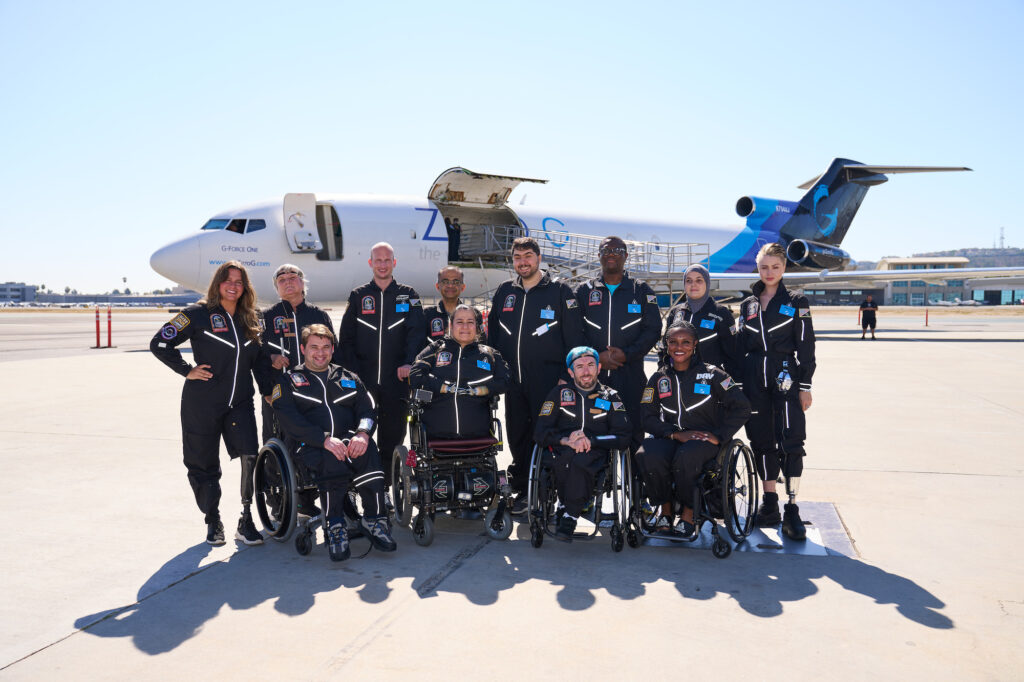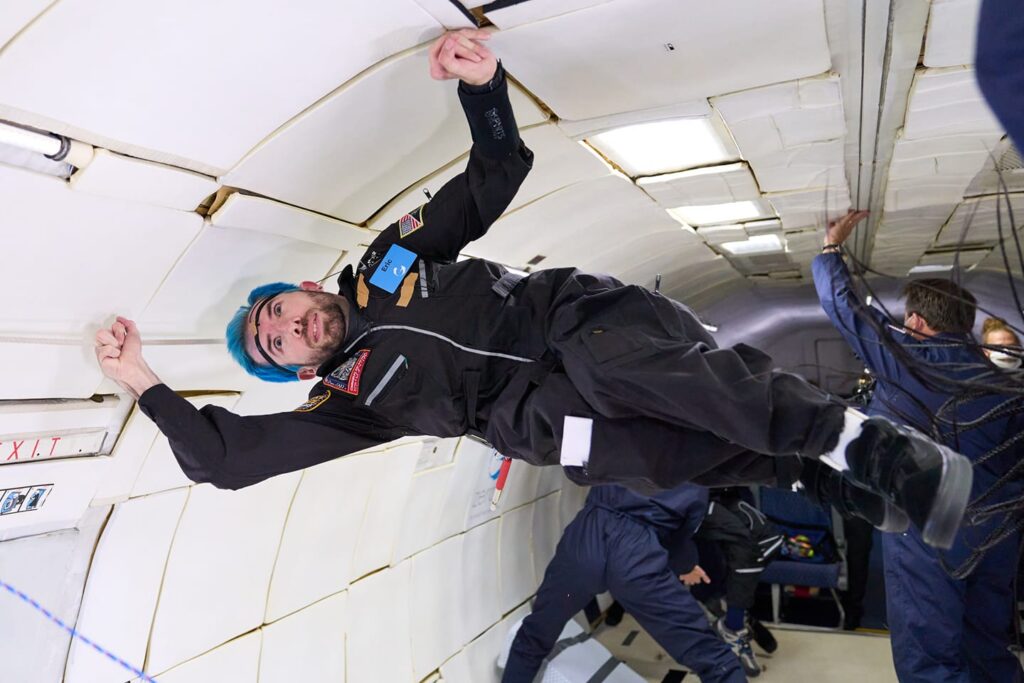
Sawyer Rosenstein, 27, is from Jupiter.
No, not that Jupiter. He’s a TV news producer from Jupiter, Florida, who also does a podcast called Talking Space and happens to be a T10-12 paraplegic since the age of 12. Not long after being injured, he went to a summer camp that runs simulated space missions for children. “I wasn’t really a huge space fan, but I thought it was interesting,” says Rosenstein. “So I went there for summer camp and became the camper that never left.”
His initial love of all things space eventually led him to cover NASA’s last space shuttle launch in 2011 as a member of the press. “That was it for me. I knew I wanted to do journalism and in particular, space journalism. That’s what started my career in both regular TV news journalism and covering space,” he says. From there, Rosenstein learned of Mission: AstroAccess, a project dedicated to promoting disability inclusion in space exploration, a first step toward the larger goal of flying a diverse range of people to space. In mid-September 2021, he and three other wheelchair users were chosen as part of a group of 12 disabled “ambassadors” who took part in AstroAccess’ first suborbital parabolic research flight.

Into the Atmosphere
The flight took off Oct. 17 and did not require participants to climb a launch tower of seven flights of stairs in under 90 seconds like Jeff Bezos’ space flight requirements. Instead, they boarded a converted Boeing 727-200 cargo plane that is much like a regular passenger airline plane but easier to board for wheelchair users. Inside were 38 first-class passenger seats with standard seat belts mounted in the rear of the aircraft. At the front was a large, open area 66 feet long, 10 feet wide and 7 feet tall — with padded walls — for experiencing various levels of weightlessness.
Their mission was to fly 15 successive parabolic arcs ranging from 24,000 feet to 32,000 feet over the Pacific Ocean. It started with two sets of three parabolas each that simulated limited gravity, first similar to Martian then to lunar gravity. After those, it was onto the highlight: 12 parabolas with a 22-second period of complete weightlessness.
Rosenstein’s first tasks were to prove that he could stay in place in a limited gravity environment, control his body position, and move from place to place in the cabin — including the return to his seated station on a cushion on the open floor space.
“In the first step, Martian gravity, I pushed off my floor cushion with my hand and was bouncing up and down like a frog, basically,” says Rosenstein. “There’s not really much I can do in that.”
Lunar gravity was far different. He pushed and his upper body floated up while his feet stayed put on the floor. “After a few seconds, I stopped and looked at the two people who were helping me and realized I was standing. So I quickly put my arms on their shoulders. And I literally just stood there. And I remember shouting, ‘Oh, my God, I’m standing!’ For the first time in 15 years, I was actually upright,” he says. “The three of us had the biggest grins on our faces after realizing what just happened. After 30 seconds passed, we came back down and they said, ‘So what do you want to do for the second lunar gravity?’ and I said, ‘I want to do that again!’”
Then came zero gravity. Again, he pushed off from his floor cushion and started moving up, but this time there was no stopping, so he quickly grabbed onto a handrail. “It’s such a bizarre feeling, like when you get to the top of a roller coaster and are about to go over the edge,” he says. “You kind of feel like you’re floating out of your seat except you just stay there, it’s not shaking you around. The blood doesn’t rush to your head or anything, no matter what orientation you’re in with the weightlessness. And honestly, my body felt really good. For the first time in a long time I realized I wasn’t in any pain, you know, the neck and shoulder and arm and wrist pain from wheeling … It’s amazing how the body so quickly adapts to that and how good it felt.”

Problem-solving in Zero G
In addition to seeing how people with different types of disabilities cope with the demands of partial and zero gravity, another goal of the flight was to find out what access problems there are in existing space flight environments. Eric Ingram, another wheelchair user who served as an ambassador on the AstroAccess flight, says that one of the biggest issues in a zero-gravity environment is staying still. “In the International Space Station, for example, the way most astronauts stay still is using foot holds,” says Ingram, who also serves as the chief executive of SCOUT, a company that develops tracking sensors and systems for satellites. But foot holds don’t work for many wheelchair users or people with lower limb amputations.
Ingram and others at AstroAccess want to make sure that solutions are as simple and applicable to the widest number of people as possible. One clever option is to use handhold straps that also have tactile markers that could be used by people with limited vision to tell where they are in a spacecraft and what direction they’re facing. “Then you’re solving for multiple groups with a simplistic design. That makes it much more effective,” he says.

While in zero gravity, Rosenstein learned he needed hand holds and more, since he needed to have both hands free to do tasks. He talked with astronaut Cady Coleman, and she mentioned a semi-rigid mechanism they use on their space suits for spacewalking flights to attach themselves in place while still allowing some mobility and free use of the hands. “Something like that would be fantastic. Something that already exists in NASA technology,” says Rosenstein.
Most inventions for getting around in space aren’t high-tech though. Rosenstein says he used simple Velcro straps to hold his legs together and a thigh loop on his pants to slip two fingers under and help position his lower body. “With weightlessness, one finger goes a long way. I could make my legs bend up into a kneeling position,” he says.
The First of Many?
More than just claiming a space for participation in space travel, AstroAccess is determined to ensure people with disabilities are involved in the critical stage of planning. “We’re at a point where these spacecraft are so new that it’s very easy to go in and modify them now, to make them accessible, so you build that into spacecraft design and avoid expensive retrofitting,” says Rosenstein. “And to prove that the modifications that you would have to meet for a spacecraft are minimal. All it took for me to make this happen was basically duct tape, Velcro and a foam pillow. I also completed every single task, which means that we can easily modify the spacecraft, so everyone gets a chance to see the earth and to go into space.”
Ingram is a member of Space Frontier Foundation, which is “dedicated to advocacy and opening the space frontier for settlement.” All of this would have greatly pleased the late Stephen Hawking, the celebrated astrophysicist who experienced weightlessness on a suborbital flight and famously said in 2010, “I believe that the long-term future of the human race must be in space.”
Ingram says there is a lot of interest from private space flight companies about things they can do proactively to make their spacecraft more accessible. He says the whole point of this flight was not to be a one-off, but to be a foundation for a whole series of flights that expand upon the research and develop the capabilities. “I want to do a whole flight of just lunar prevalence,” he says. “Maybe there are therapeutic things for spinal cord injuries, maybe new things we can figure out, like body movement and stuff like that. I think there’s a lot of intrigue there that I would not have anticipated before the flight, like how it changes your basic functional abilities within partial gravity.”
Maybe Stephen Hawking had already envisioned this. The moon seems to be a logical place to begin research, as well as habitation of nearby planets. Can you imagine leaving your wheelchair behind to float about lightly on the moon, where pressure sores no longer exist, your shoulders never wear out and you feel no pain?
Support New MobilityWait! Before you wander off to other parts of the internet, please consider supporting New Mobility. For more than three decades, New Mobility has published groundbreaking content for active wheelchair users. We share practical advice from wheelchair users across the country, review life-changing technology and demand equity in healthcare, travel and all facets of life. But none of this is cheap, easy or profitable. Your support helps us give wheelchair users the resources to build a fulfilling life. |


Recent Comments
DINOS PITSILLIDES on Functional Fitness: How To Make Your Transfers Easier
Stosh on Functional Fitness: How To Make Your Transfers Easier
Bill on LapStacker Relaunches Wheelchair Carrying System